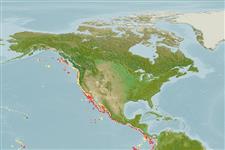Actinopterygii (ray-finned fishes) >
Lophiiformes (Anglerfishes) >
Ogcocephalidae (Batfishes)
Etymology: Dibranchus: Greek, di = two + Greek, brangchia = gills (Ref. 45335).
Environment / Climate / Range
Ecology
Marine; bathydemersal; depth range 700 - 1244 m (Ref. 40826). Deep-water, preferred ?
Eastern Central Pacific: Mexico, including the Revillagigedo Islands.
Size / Weight / Age
Maturity: Lm ? range ? - ? cm
Max length : 13.3 cm SL male/unsexed; (Ref. 40826)
Short description
Morphology | Morphometrics
Dorsal
soft rays
(total): 5-6;
Anal
soft rays: 4;
Vertebrae: 18 - 19. Body flabby with thin, translucent skin. Subopercular lateral-line count usually 5. Skull relatively long, at least 30% of SL. Lower lip with membranous fringe of fingerlike papilla. Gill rakers in the form of broad tooth plates attached directly to gill arch,; no pedicels evident. Slender fins moderate in length with thin and transparent membranes. Cephalic lateral-line counts: subopercular usually 5 (5-6); preopercular 2. Tail lateral-line counts 8-11 (Ref. 40826).
Life cycle and mating behavior
Maturity | Reproduction | Spawning | Eggs | Fecundity | Larvae
Bradbury, M.G., 1999. A review of the fish genus Dibranchus with descriptions of new species and a new genus, Solocisquama (Lophiiformes, Ogcocephalidae). Proc. Calif. Acad. Sci. 51(5):259-310. (Ref. 40826)
IUCN Red List Status (Ref. 115185)
CITES (Ref. 94142)
Not Evaluated
Threat to humans
Harmless
Human uses
More information
Common namesSynonymsMetabolismPredatorsEcotoxicologyReproductionMaturitySpawningFecundityEggsEgg development
Age/SizeGrowthLength-weightLength-lengthLength-frequenciesMorphometricsMorphologyLarvaeLarval dynamicsRecruitmentAbundance
ReferencesAquacultureAquaculture profileStrainsGeneticsAllele frequenciesHeritabilityDiseasesProcessingMass conversion
Tools
Special reports
Download XML
Internet sources
